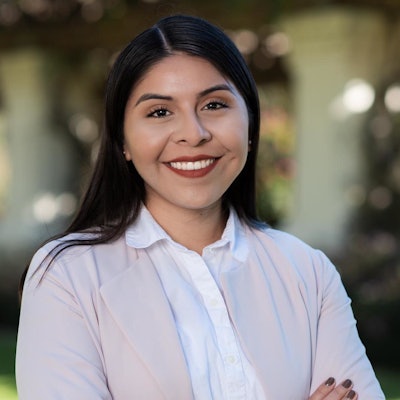There needs to be more, not fewer opportunities to assist students of color on campuses, according to a new report from The Education Trust. Jessie Hernández-Reyes
Jessie Hernández-Reyes
The report, Creating Positive College Campus Racial Climates for Students of Color, highlights the perspectives of students of color with regard to their experiences on campus and campus racial climates, and also provide suggestions on measuring and improving these climates.
Campus racial climate is defined in the report as the “current attitudes, behaviors, and practices of faculty and students at a higher education institution toward students based on their race/ethnicity.”
"There's more than 25 years of research by academic scholars on the experiences of students of color,” said Jessie Hernández-Reyes, lead author and senior policy analyst for higher education at EdTrust. “We've seen time and time again through that research that the experiences that these students have is different from their white peers, specifically because of how staff, faculty, and peers have different attitudes, behaviors, and practices towards students of color due to their perceived or actual race or ethnicity."
In light of the U.S. Supreme Court’s decision this year to ban race-conscious admissions and “the attacks that we're seeing subsequently on DEI in the states,” it’s crucial to assess the campus racial climate today, said Hernández-Reyes.
“In the wake of the Supreme Court’s limitation on the use of affirmative action, some colleges are doing away with their efforts to advance diversity, equity, and inclusion (DEI) on campus; but we argue that there needs to be even greater efforts on college campuses to support the belonging and success of students of color, not fewer,” the report stated.
For the report, EdTrust researchers interviewed 32 Black, Latino, and Asian American students enrolled at predominantly White institutions (PWIs) in 15 U.S. states, gauging their thoughts on what their respective campuses could be doing better.
Many PWIs have historically been rooted in the exclusion of students of color through means such as admissions practices, Hernández-Reyes said.
The students interviewed voiced concerns about a number of deficiencies on their campuses, including a lack of students and faculty of color; limited support from their school; insufficient information about reporting processes for incidents of racial/ethnic discrimination; and not having mental health supports specifically for students of color.
“Sometimes in class, I will say something about the Black identity or the distinction between African American, African and Afro-Caribbean and I’ve had professors that just say, ‘Wow, that’s so powerful. Let’s move to page 47,’” Sabrina, a Black student who was interviewed by EdTrust for the report, said about their school not having enough support for students of color.
Another Black student, Ava, was interviewed about the distinctly few counselors of color available at her school’s counseling center.
“Unfortunately, there’s only one Black person,” Ava said. “She’s able to connect with me and see things that I’m telling her in a different perspective. But it sucks on her end, too, that she’s the only Black therapist; so many people of color are coming to her.”
Interviewed students described experiences of racism; of being one of the only few students of color in a class; of feeling a responsibility and pressure to be representative of their community; of being disappointed for not having a role model of color; and of feeling unsafe near campus security.
“On a study abroad, my professor said, ‘There’s this area between France and Germany that’s disputed.’ Then she looked at me and said, ‘Faye, you would know what it’s like to be from a war-torn area, right?’ Faye, an Asian American student who was interviewed for the report, said about microaggressions and racism in the classroom. “Then, she commented how a Black student didn’t need sunscreen because she was Black, but the rest of us did. The same student had an asthma attack and the teacher said she was faking it, so she didn’t help her get medical attention.”
To help address these widespread issues, the students made several suggestions of actions their schools could take to improve its campus racial climates.
The recommendations ranged from straightforward acts, such as faculty mentoring and hiring more faculty of color, to more open-ended practices, such as holding meetings between racial/ethnic student organizations and college trustees about racialized issues and establishing well-funded cultural centers.
"It's not enough to just have more students and faculty of color on campus,” said Hernández-Reyes. “There has to be really intentional education and incorporation of that education into the curriculum to foster those conversations on understanding students and people of different racial/ethnic backgrounds."
EdTrust itself proposed several recommendations for the situations, theirs instead aimed towards state and federal policymakers, including accounting for campus climate metrics in state funding measures; informing incoming and current students about anti-discrimination policies and existing complaint processes; assessing the racial/ethnic diversity of Boards of Trustees; and requiring schools to measure campus racial climate on a yearly basis.
The report also featured a framework with which higher ed leaders and students can gauge the racial climates on their own campuses. The framework – created by other researchers in 1998 – aims to assess campus climates from four angles: historical legacy of inclusion/exclusion; structural diversity and representation; psychological climate and attitudes; and faculty and student social behaviors and interactions.
“College leaders need to be vigilant, in the current educational landscape, of how students of color are being treated and their experiences on campuses, the mechanisms that are in place or not in place for reporting, and the spaces we need to create for students to feel a sense of belonging at institutions where they may be confronted with a hostile campus culture,” said Dr. Wil Del Pilar, senior vice president at EdTrust.





















